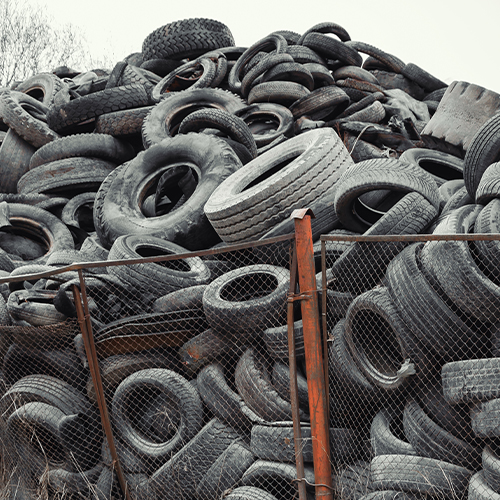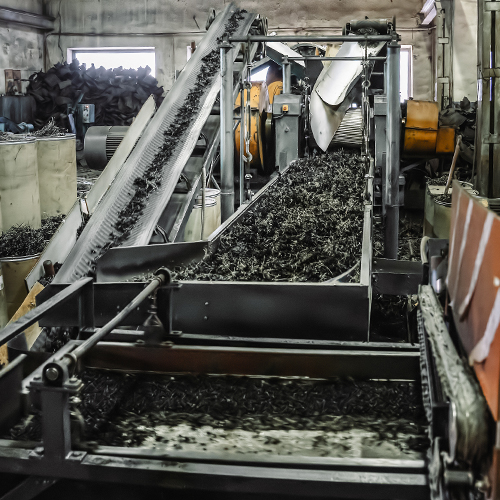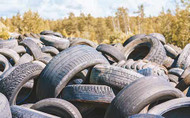Tire Recycling Technologies
Posted by Agota Szabo on May 19th 2022
Tire recycling is crucial, as the condition of tires gets to the point where you just can't use them anymore. We call these tires waste tires or end-of-life tires. As the World Business Council for Sustainable Development has evaluated, we generate about one billion of these tires annually.
It is a huge problem for the rubber industry if all that waste rubber is just laying around in landfills. There has to be a patented technology in place for recycling rubber in huge amounts. Several companies have set their aim to develop the most efficient rubber recycling methods.
They are in the search for eco-friendly solutions that turn old tires into premium rubber. The raw rubber goes through a devulcanization process that converts it into material that can be reused in the rubber industry.

This was not always the case according to the Rubber Manufacturers Association. There were huge mountains of scrap tires stored in American landfills in the '70s and '80s. Nowadays, there are fewer and fewer high-cost methods. The focus is rather on developing processes that turn waste rubber into high-quality raw material for a low cost.
There are companies that want to develop sustainable synthetic rubber. Meanwhile, others want to turn waste rubber into close to virgin-quality raw materials. Below, we are going to talk about these technologies and also why recycling is important.
Why Reducing Waste Tires is Important?
Tires release plenty of toxic gasses when burned. But even if they weren't toxic, they definitely take up a lot of space. Landfills quickly get out of control as scrap tires start to flow in. Also, old tires cause environmental damage over time, by trapping gasses under the ground.
There are millions of waste tires out there every moment. They need to be recycled or reused in order to reduce environmental damage and lower the carbon footprint as a result. Otherwise, it would just accelerate global warming, which already hugely impacts people's lives.
Waste rubber is a great breeding ground for rodents and insects. If you just leave them on the ground, they will eventually turn into a complete health hazard. Diseases spread by those pests can be very dangerous to both pets and humans.
On the other hand, rubber is highly flammable due to the materials used to make it. They can burn for a long time once they catch fire, releasing various dangerous toxins. The pitch-black smoke and the unbearable smell can cause respiratory distress.
Not to mention that melted tires release numerous chemicals that end up contaminating the water supply below. It can mess up our precious drinking water, which is already endangered or depleted in many places around the World.
What to do with End of Life Tires?
There is a high number of other products that can be produced from rubber or even directly from scrap tires. You can make use of the rubber's shock-absorbing ability anywhere around the house. For example, it is widely used in children's playgrounds for teeter-tooters.
Recycling waste rubber is a great way to preserve our planet's resources. There are technologies that enable us to gain energy from recycled rubber in the form of liquid or gaseous fuel. They can also be reduced to their original elements through various methods.
Then, those elements can be used either to manufacture new tires or to produce something else from rubber. Each new technology in the field of tire recycling helps us better deal with this ecological challenge. We have already taken many steps toward sustainable development as industry experts developed numerous complex methods.
How can old tires be reused?
Old tires make outstanding crafting materials. They can also be reused in road construction, for producing new rubber products, and to produce tire-derived fuel. There are various ways to repurpose them at home as well. People widely use them to create chairs, end tables, ottomans, garden beds, yard art, etc.
Those tires still have the mechanical properties required for certain applications. They can hold gravel, absorb shock, and hold a certain amount of weight. Old whole tires such as truck tires are widely used in gardens for decoration and as seating commodities as well.
Are tires actually recycled?
Before 1980, there were billions of waste tires stockpiled in landfills. Since then, companies have recycled 90% of those into usable rubber. Nowadays, we recycle approximately 80% of scrap tires on an annual basis. This equals 240 million of them every year. You can submit old tires for recycling at many dealer shops.
There are various technologies that either turn used tires into fuel or break them into raw materials. Some of them are more effective, while others leave some byproducts or contaminated rubber materials. In general, we are inching toward technologies that produce carbon black, pure crumb rubber, or rubber powder.
Some of these methods separate the tire's other components as well, such as metals and polymers. Then, these goods can be used to create new rubber products, maintaining the material cycle with high efficiency.
What can be made by recycling tires?
We can use the ground rubber in end-of-life tires as fuel either through pyrolysis or by burning. This way, we recycle almost all the rubber, which makes these two the most environmentally-friendly methods. Effective recycling is usually about producing secondary raw materials.

We can reuse the waste rubber and carbon created as a result, in the form of different particle sizes. These methods are all company-based and support an eco-friendly approach to tire recycling. The carbon black produced from some of the methods is close to the quality of virgin carbon black.
Producing raw materials that can be reduced is a huge business that offers a remedy to the alarmingly larger amount of waste rubber produced by the tire industry.
DIY Tire Recycling?
You can actually repurpose tires at home with relative ease. They might not be safe for driving, but that doesn't mean they are not durable enough for other purposes. Of course, it is also okay to submit them for recycling at the nearest tire dealership or mechanic.
There is a high number of home DIY projects that only require a couple of extra materials. You can turn your old truck tire into a useful item with some ropes and paint, for example. It is a great opportunity to get creative and come up with new stuff that can be used around the house.
Get crafty and use that rubber to upgrade your home or garden, or maybe build something huge out of them for your kids. They are commonly used for teeter-totters, garden stairs, outdoor seating commodities, tire swings, and holiday decorations as well.
The Latest Tire Recycling Technologies
Since the idea of rubber recycling has emerged, people are trying to find the best tire recycling technology. The goal is to develop processes that turn end-of-life tires into valuable crumb rubber, carbon, and steel. We can use these to produce other rubber goods in the rubber industry.
There is a constantly ongoing search for the best technology. Many companies are working on their own eco-friendly patented technology that takes tire recycling to the next level. The goal is to end up with premium carbon and other raw components and to collect valuable data.

Every technology requires the respective company to carefully go through the details and re-iterate certain steps in the rubber recycling process. With this data, they can improve their services and produce rubber that meets the highest standards.
Now, let's talk a bit about each tire recycling technology that turns end-of-life tires into valuable material.
Pyrum-Thermolysis
The technology called Pyrum-Thermolysis is used to recycle waste tires and plastic through a process that excludes oxygen. A Germany-based company named Pyrum Innovations does this, which owns numerous recycling plants.
The whole process requires Pyrum extracts, which are essential for producing raw materials from waste tires. At the end, they get plastic and rubber in high quantities with high production efficiency. These goods are ready to re-enter the material cycle.
The resulting goods include thermolysis oil and carbon black as well. Pyrum supplies large quantities of its raw components to contractual partners worldwide.
Cryogenic Freezing
The first step of the cyrogenic freezing process is to freeze the tires with liquid nitrogen. Then, they smash the tires into pieces with a hammer mill while being in that solid-state. A huge benefit of this method is that we can easily remove the steel pieces with the help of a strong magnet.
Tires contain other materials as well such as nylon, textile fibers, and polyester that the technoloy can collect using an air classifier. The rest is really just reusable rubber that can re-enter the material cycle. There are plenty of ways to turn them into new products in the rubber industry.
Renewable Tires
Bridgestone and LanzaTech together took a step toward carbon neutrality. They wanted a new, scaled solution for recycling scrap tires. They want to decarbonize the production of new tires while guaranteeing a circular economy.
What this means is they are going to develop a technology that enables them to manufacture their tires from 100% renewable materials. They hope to finish the whole project by 2050 and deal with the waste tire problem with high efficiency.
With their advanced method, they will be able to create sustainable synthetic rubber without having to rely on petrochemicals. They are taking a huge step toward end-to-end material circularity.
No More Metal Contamination
Many new methods revolve around reducing metal contamination in recycled rubber. These processes use magnetic separation to get higher-quality raw materials. For this, all they need to do is to remove the excess metal during certain phases of the recycling process by using a strong magnet.
This is especially important due to the fact that playgrounds and gardens (for gravel substitutes) and various consumer items sell used tires. In those tires, metal contamination can be dangerous. By leaving metal parts like steel wires in the tire, we essentially lose good quality rubber.
This is why multi-stage magnetic separation was invented. By separating rubber goods from metal, we can end up with valuable raw materials from used tires.
Pyrolysis
Pyrolysis is a heat-based technology that breaks down tires into their constituent elements. This all happens in an oxygen-free reactor where they heat up and gradually soften them into vulcanized rubber. The technology can recycle both whole and shredded tires.
In the reactor, the heat eventually reaches a point where polymers start to break down. This is when the tires start to emit molecules in a gaseous form. These gasses are highly valuable, as the technology turns their smaller molecules into fluid fuel via condensation.
Larger molecules burn right away, which is another efficient way to generate power from rubber. Of course, this technology won't turn the entirety of the tire into fuel. About 40% of the tire components will end up as ash that can be collected afterward.
What does the Future of Tire Recycling Hold?
Companies are constantly trying out new tire recycling methods. A company named Genan conceived one of the tire recycling concepts. This has still in development since 1990. Their idea is to break tires down to their initial raw elements through a highly technological process. Almost all tire types can go through this process.
Two Australian companies, Green Distillation Technologies and CarbonScape, developed another patented technology. They extract the carbon from end-of-life tires and turn it into high-value graphite throughout the recycling process.

Wastefront focuses on generating alternative fuel and ground rubber. They do so by recycling scrap tires into carbon black and liquid hydrocarbons. The company reutilizes them for the production of useful commodities.
RubberJet Valley produces polymers in powder and granule form. Their engineered raw materials are made of waste tires. This way, they offer a replacement for virgin raw materials, such as natural rubber. They use these materials to make new tires.
The list goes on and on, as there are many technologies available for tire recycling. It has become a huge business where each company is on the search for the most effective technology to recycle tire materials. The field itself has evolved a lot in the past couple of decades. With so many companies working on new technologies, we can already foresee a bright future in this regard.
















